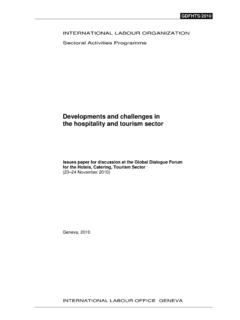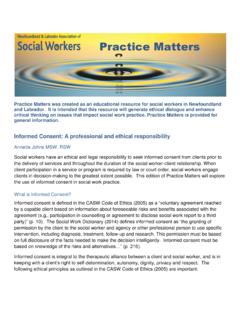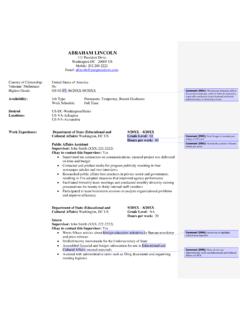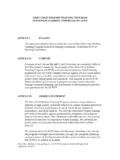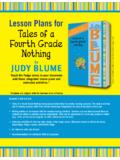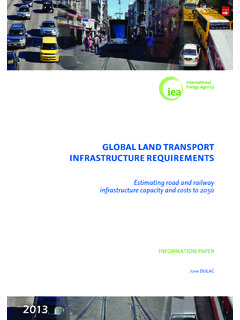Transcription of The New York Declaration for Refugees and Migrants
1 1 THE NEW york Declaration FAQs The New york Declaration for Refugees and Migrants Answers to Frequently Asked Questions The New york Declaration for Refugees and Migrants .. 2 1. What is it? .. 2 2. Why is it important for Refugees ? .. 2 3. What is new in it? .. 2 4. Does it cover all those forced to flee their countries?.. 3 5. Are vulnerable Migrants in the same situation as Refugees ? .. 3 Comprehensive Refugee Response Framework .. 3 6. What is it? .. 3 7. How is the CRRF different from current approaches to refugee responses? .. 4 8. How will the CRRF be applied? .. 4 Global Compact on Refugees .. 4 9. What is it? .. 4 10. Will it be legally binding? .. 5 11. How does it interact with the 1951 Refugee Convention? .. 5 Global compact for safe, orderly and regular migration .. 5 12. What is it? .. 5 13. How is the migration compact different from the global compact on Refugees ?
2 5 14. What is UNHCR s position in regard to the global compact on safe, orderly and regular migration? .. 6 15. What is UNHCR s role in relation to the global compact on safe, orderly and regular migration? .. 6 Relationship between the two global compacts .. 6 16. What is a global compact? .. 6 17. Why are there two compacts? .. 6 18. How will the two compacts relate to one another? .. 7 2 THE NEW york Declaration FAQs The New york Declaration for Refugees and Migrants 1. What is it? On 19 September 2016, the United Nations General Assembly hosted a high-level Summit for Refugees and Migrants that aimed at improving the way in which the international community responds to large movements of Refugees and Migrants . At the Summit, all 193 Member States of the United Nations unanimously adopted the New york Declaration for Refugees and Migrants (Resolution 71/1).
3 As the name suggests, the New york Declaration for Refugees and Migrants addresses the situations faced by Refugees and by Migrants . There are robust commitments that apply equally to Refugees and Migrants (on topics including racism, xenophobia and human trafficking), as well as separate commitments for Refugees and for Migrants . Furthermore, the New york Declaration lays the groundwork for further action to improve the situation of Refugees and Migrants by laying out a process for the development of two global compacts , one on Refugees and the other for safe, orderly and regular migration, which are to be adopted in late 2018. States have also pledged to consider the development of non-binding guiding principles for Migrants in vulnerable situations. For further information, visit.
4 2. Why is it important for Refugees ? The New york Declaration is a milestone for global solidarity and refugee protection at this time of unprecedented displacement. The set of commitments, agreed by Member States, reflects an understanding that protecting those who are forced to flee, and supporting the countries that shelter them, are shared international responsibilities that must be borne more equitably and predictably. In the Declaration , all 193 Member States of the United Nations reaffirmed the enduring importance of the international refugee protection regime, committed fully to respect the rights of Refugees and Migrants , pledged to provide more predictable and sustainable support to Refugees and the communities that host them, and agreed to expand opportunities to achieve durable solutions for Refugees .
5 The next day at the Leaders Summit, 47 States committed to legal or policy changes to enhance Refugees access to education, lawful employment and social services, substantially increased humanitarian aid; and expand access to third-country solutions. In order to give life to these commitments, the New york Declaration also sets out the key elements of a comprehensive refugee response and lays the groundwork for the adoption of a global compact on Refugees in late 2018, both of which are explained in greater detail below. 3. What is new in it? Among the key new elements are commitments by States to: Strengthen and facilitate emergency responses to refugee movements and a smooth transition to sustainable approaches that invest in the resilience of both Refugees and the communities that host them; Provide additional and predictable humanitarian funding and development support to host countries; Explore additional avenues for Refugees to be admitted to third countries, including through increased resettlement; and Support the development and application of a comprehensive refugee response framework (CRRF) for large refugee movements, applicable to both protracted and new situations.
6 3 THE NEW york Declaration FAQs 4. Does it cover all those forced to flee their countries? The New york Declaration addresses large movements of Refugees and Migrants . It covers all Refugees . A refugee is understood in international law to be a person who is outside his or her country of origin and who cannot return due to a well-founded fear of persecution for reasons of race, religion, nationality, membership of a particular social group or political opinion. The person is in need of international protection when his or her country of origin is unable or unwilling to provide protection against the harm feared. This definition is at the heart of the 1951 Refugee Convention and its 1967 Protocol and is also reflected in regional instruments. It has broad and enduring scope.
7 It encompasses those who flee individual persecution, as well as those fleeing armed conflict or violence associated with one or more of the above-noted grounds. It includes those fleeing State and non-State actors and has been the basis for providing protection, amongst others, for those escaping war, conflict, human rights abuses, gang violence, domestic abuse and other forms of harm. There may also be persons who are forced to flee or are displaced across borders in the context of sudden- or slow-onset disasters, or in the context of the effects of climate change, who are not Refugees . This group is also covered by the New york Declaration . 5. Are vulnerable Migrants in the same situation as Refugees ? There are some situations where Migrants and Refugees face similar risks. These include: Exploitation or abuse by smugglers/traffickers or unscrupulous employers; and, Risk of harm due to personal circumstances.
8 People in this category could include, for example, unaccompanied or separated children, women at risk, elderly people, persons with disabilities or medical needs, or survivors of torture or trauma. While Refugees often share the same vulnerabilities as Migrants when they travel in similar conditions and along the same routes, it is important to bear in mind that Refugees have an additional vulnerability that Migrants do not, namely the well-founded fear of persecution that makes them a refugee. They are unable to avail themselves of the protection of the State that they have fled, which is why the international community has long recognized the additional duties owed to Refugees , as enshrined in the 1951 Refugees Convention, its 1967 Protocol, regional instruments, and the corresponding rules of customary international law.
9 Comprehensive Refugee Response Framework 6. What is it? The New york Declaration sets out the key elements of a comprehensive refugee response framework which are presented in the paragraph below. In the Declaration , UN Member States request UNHCR to engage with States and consult all relevant stakeholders to apply the comprehensive framework, and to further develop it in each situation involving large movements of Refugees . The framework presents a comprehensive response designed to ensure a) rapid and well-supported reception and admission measures; b) support for immediate and ongoing needs ( , protection, health, education); c) assistance to national/local institutions and communities receiving Refugees ; and, d) expanded opportunities for durable solutions. These elements are designed to meet four objectives: to ease pressures on countries that host large numbers of Refugees , to enhance refugee self-reliance, to expand third-country solutions, and to support conditions in countries of origin for return in safety and dignity.
10 4 THE NEW york Declaration FAQs The elements of the CRRF elaborated in the New york Declaration draw on best practices from over 65 years of experience in international refugee protection, humanitarian assistance and the search for solutions. The elements, while comprehensive, are not necessarily exhaustive. 7. How is the CRRF different from current approaches to refugee responses? Rather than responding to refugee displacement through a purely, and often underfunded, humanitarian lens, the elements of the CRRF are designed to provide a more systematic and sustainable response that benefits both Refugees and the communities that host them. It engages a much broader group of stakeholders: government at national and local levels, international and regional financial institutions, UN Agencies and NGO partners, Refugees themselves, the private sector, and civil society actors.











